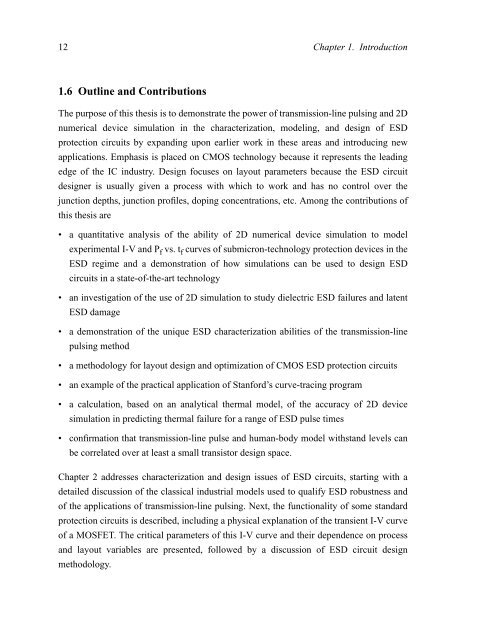characterization, modeling, and design of esd protection circuits
characterization, modeling, and design of esd protection circuits
characterization, modeling, and design of esd protection circuits
Create successful ePaper yourself
Turn your PDF publications into a flip-book with our unique Google optimized e-Paper software.
12 Chapter 1. Introduction<br />
1.6 Outline <strong>and</strong> Contributions<br />
The purpose <strong>of</strong> this thesis is to demonstrate the power <strong>of</strong> transmission-line pulsing <strong>and</strong> 2D<br />
numerical device simulation in the <strong>characterization</strong>, <strong>modeling</strong>, <strong>and</strong> <strong>design</strong> <strong>of</strong> ESD<br />
<strong>protection</strong> <strong>circuits</strong> by exp<strong>and</strong>ing upon earlier work in these areas <strong>and</strong> introducing new<br />
applications. Emphasis is placed on CMOS technology because it represents the leading<br />
edge <strong>of</strong> the IC industry. Design focuses on layout parameters because the ESD circuit<br />
<strong>design</strong>er is usually given a process with which to work <strong>and</strong> has no control over the<br />
junction depths, junction pr<strong>of</strong>iles, doping concentrations, etc. Among the contributions <strong>of</strong><br />
this thesis are<br />
• a quantitative analysis <strong>of</strong> the ability <strong>of</strong> 2D numerical device simulation to model<br />
experimental I-V <strong>and</strong> Pf vs. tf curves <strong>of</strong> submicron-technology <strong>protection</strong> devices in the<br />
ESD regime <strong>and</strong> a demonstration <strong>of</strong> how simulations can be used to <strong>design</strong> ESD<br />
<strong>circuits</strong> in a state-<strong>of</strong>-the-art technology<br />
• an investigation <strong>of</strong> the use <strong>of</strong> 2D simulation to study dielectric ESD failures <strong>and</strong> latent<br />
ESD damage<br />
• a demonstration <strong>of</strong> the unique ESD <strong>characterization</strong> abilities <strong>of</strong> the transmission-line<br />
pulsing method<br />
• a methodology for layout <strong>design</strong> <strong>and</strong> optimization <strong>of</strong> CMOS ESD <strong>protection</strong> <strong>circuits</strong><br />
• an example <strong>of</strong> the practical application <strong>of</strong> Stanford’s curve-tracing program<br />
• a calculation, based on an analytical thermal model, <strong>of</strong> the accuracy <strong>of</strong> 2D device<br />
simulation in predicting thermal failure for a range <strong>of</strong> ESD pulse times<br />
• confirmation that transmission-line pulse <strong>and</strong> human-body model withst<strong>and</strong> levels can<br />
be correlated over at least a small transistor <strong>design</strong> space.<br />
Chapter 2 addresses <strong>characterization</strong> <strong>and</strong> <strong>design</strong> issues <strong>of</strong> ESD <strong>circuits</strong>, starting with a<br />
detailed discussion <strong>of</strong> the classical industrial models used to qualify ESD robustness <strong>and</strong><br />
<strong>of</strong> the applications <strong>of</strong> transmission-line pulsing. Next, the functionality <strong>of</strong> some st<strong>and</strong>ard<br />
<strong>protection</strong> <strong>circuits</strong> is described, including a physical explanation <strong>of</strong> the transient I-V curve<br />
<strong>of</strong> a MOSFET. The critical parameters <strong>of</strong> this I-V curve <strong>and</strong> their dependence on process<br />
<strong>and</strong> layout variables are presented, followed by a discussion <strong>of</strong> ESD circuit <strong>design</strong><br />
methodology.
















